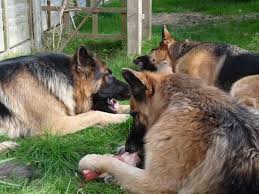Can Dog Eat Pork? Top 10 FAQs (Answered)
It is a very common fact that dog due to its carnivorous nature wants more chicken and beef to eat. We generally assume that pork is also a staple, But can dogs eat pork?
Here the answer is not a simple yes or no. We need to dig deep to know the facts. It is safe to eat pork, but there are some conditions we need to be careful about. never to assume what they can and can’t eat.
As we all know, Simple plain meat is always a harmless diet. Pork with no seasonings, spices, harmful levels of garlic, and onions are good to give. It is always safe to maintain a discipline of avoiding food transfer from owner plate to Dog plate.
Let’s see the 10 most asked questions on the Pork diet for dogs which is a must learn for every dog owner.
1. Is it good that dog eat pork?
It is very important to know what is safe and what is wrong before you give your dog pork.
Eating raw or undercooked pork is not safe for dogs or people, due to the spiral larval parasite trichinella. It can induce trichinosis, a parasitary infection. A pig meat transmission infection.
Dogs are not supposed to be eating the hog fat.
The majority of pork is high in fat, and many still include portions of fat after cooking.
The nutritional advantage of pest-raised pork versus factory pigs is considerable.
It has symptoms of:
- Upset stomach
- Vomiting
- Diarrhea
- Elevated fever
- Lethargy
- Muscle inflamation
- Pain & stiffness
2. Is there any limit for dog?
Moderation is the key to any food that our pet eats. Like any other meal, give your dog for the first time to check whether a reaction exists.
If your dog is eating a piece of pork coated with BBQ, keep an eye on any strange symptoms that may emerge. A lot of salt and sugar are high and include other flavorings like garlic and onion
3. Is there an alternative for pork diet?
If our dog can eat pork alternative foods Its a real win. You may use alternative white meats, which are nutritious and safe for your dogs if you have no time to cook the pork. Chicken is one of the better options. Chickens are rich in vitamins, proteins, and minerals that are necessary. Digesting is very easy for dogs.
Chicken, with the necessary vitamins, minerals, lipids, and amino acids are easy to digest and replenish.
Otherwise, give pork for variety only once a week. Or, in combination with turkey or mackerel fish, you may feed pork, which is both lean and “cool.”
4. Is there any nutritional benefits?
Omega-3
A review of studies indicates that pig meat contains omega-3
- 18-43% higher in pigs of free range
- 291% higher in organic pork flesh
as well as pigs from strict confinement.
Omega-6:3 better ratio.
The high Omega-6:Omega-3 ratio of porcine meat in all systems. But confined pig meat was worse.
- The ratio was 12.4-31.2:1 in farm meat
- The free range was about 11.8 to 18.1:1
High vitamin E
The content of vitamin E in free pork has also been raised
It is a good source of the following minerals:
- magnesium, phosphorus, potassium, iron, selenium, and zinc.
- About vitamins, pork meat is particularly high in
- thiamine (vitamin B1) and riboflavin (vitamin B2)
- a good source of vitamin B6
- niacin (vitamine B3)
- vitamin B12
- vitamin B6
The fat of pork is an excellent source of the important fat-soluble vitamin D, which is rare.
5. Is pork there in actual diet? Ham,sausages or Bacon?

The answer to all these meats is no! In 2015, the WHO concluded that processed meat, such as bacon and sausage, is a recognized carcinogen in connection with cancer.
Bacon is a rich fatty, salt-laden dish that might be too many for a dog’s stomach to cope with. A huge amount of food may induce deadly pancreatitis.
Ham also has a high salt level, which might result in more thirst and a fatal “bloat” condition. Bloat is when the stomach of a dog has gas, food or liquids, which expands it. Due to the high salt level in ham, dogs get thirsty and drink too much water.
6. Is cooked pork bones hurting? can dog eat pork bone?
While it could be tempting to throw that remaining bone at your dog after dinner, think again before. Even if dogs like to chew on it, It’s not 100% safe.
The bone dries out after cooked, making it delicate and frail. Once ripened, it can split into sharp shards that can cause injury to the esophagus and internal organs.
Chewing for dogs is instinctual. Look for safer options to help fulfill your dog’s urge to chew without providing bones. Regardless of what your dog will chew on, be sure you always supervise your dog.
7. Is there a procedure to plan diet?
You would have to make it special if you want to serve pork to your pet which means no seasoning and make sure to remove common fat and cook it properly.
Likewise, you shouldn’t drop a pork chop and call your dog a day. It is important that you slice it and give it only little parts and a modest quantity, especially if your dog hasn’t.
Keep a watch on your dog after giving anything above your regular diet, including pork. Note down any upset stomach, lethargy, vomiting, diarrhea, or other disturbance.
Freezing and cooking meat have also been useful. Because we’re concentrating on raw feeding. Dog can eat
First, make sure it’s well cooked, as uncooked pork might make your dog sick or possibly kill him. Second, as a dog snack, you may provide freeze-dried or prepared as dry food pork. Dried pig ears are a safe food and toy that many dogs like chewing on.
So, the next time your canine companion salivates for your pork delicacy, don’t give it to them uncooked. First, make sure it’s cooked well and that it’s completely plain.
Cuts less than six inches thick should be frozen for 20 days at 5 degrees Fahrenheit or 3 days at -4 degrees Fahrenheit.
Among the other swine parasites are:
- Roundworms
- Whipworms
- Nodular worms
- Lungworms
- Kidneyworms
Don’t worry about your dog contracting these parasites from pork. It’s quite unlikely if it was frozen as described above.
Yes, pork is a new protein. A dog, like any other animal protein source, can cause allergic reactions. If your dog appears to be allergic to pork, avoid pork products and substitute acceptable alternatives.
Pork isn’t the most nutrient-dense meat, but when combined with pork organ meats, you can put together a very excellent diet.
8. Is there a suitable way to give pork for dog breeds?
Fresh, well-cooked lean pork with no spices, additives, or bones is suitable for all dogs, including
- pit bulls
- pugs
- Chihuahuas
- Shi Tzu
- bulldogs
- Pomeranians and German shepherds, as well as tiny, large, and weaned pups.
Yet, while it is nutritious, it should only be rare and in moderation, i.e., as a tiny part of the diet.
9. Is there a variety? can dog eat any pork varieties?
Pork kibble is completely safe. In general, kibble or wet food containing pig protein is a good choice for healthy dogs. However, before making a transition, it’s always a good idea to consult with your veterinarian about potential dog food.
Cooked pork is fine as a treat for most dogs.
If you want to treat your dog to some freshly cooked pork but make be sure it’s done safely. To reduce the danger of spreading food-borne parasites, the pig should be deboned and cooked to at least 160 degrees Fahrenheit. You should also feed Fido meat in tiny amounts.
Seasoning should be less. Dogs should not consume heavily salted foods such as bacon, ham, or cured pig.
Even in tiny doses, common cooking spices such as garlic, onions, and others can be harmful to dogs.
10. Is there any danger with pork specials?
Pig rinds, pork scraps, and pork skin purchased in packages are all prepared with a lot of salt, spices, and other frying processes that might be hazardous to your pet’s health and should be avoided.
But don’t worry, chicharron isn’t harmful to your dog’s health. If you gave them one or the other to try, there is no need for you to run to the vet.
Even though it is unlikely that your dog would have an allergic reaction after eating a pig rind, it depends on the dog. Keep an eye on them if you know they have a sensitive stomach or digestive difficulties.
Credit: Photos by Anrew Molyneaux on Unsplash and Mogens petersen on Pixabay.






